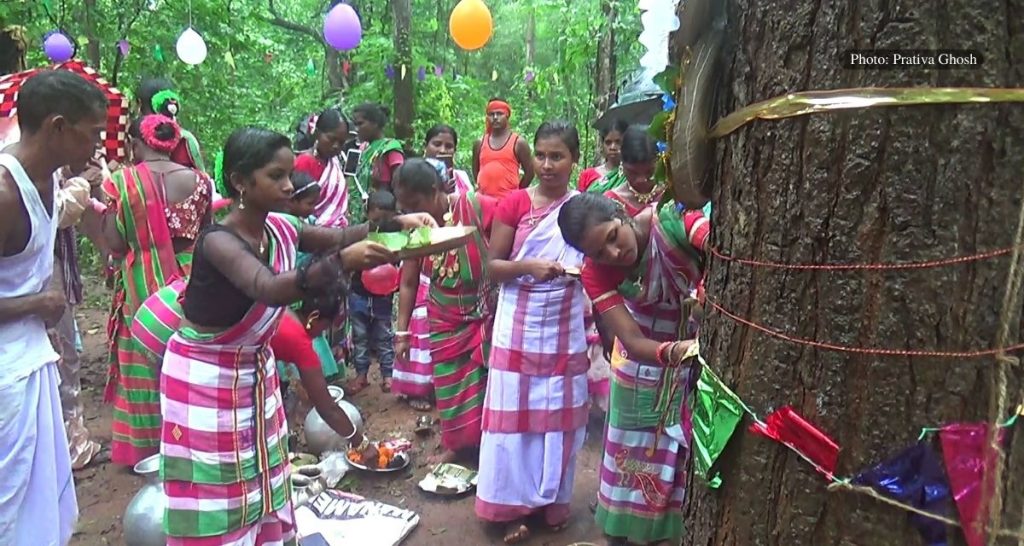Mayurbhanj: Hundreds of acres of forestland in Mayurbhanj district are safe today, thanks to the Jungle Raksha Bandhan Utsav organised annually by the tribal communities here. As part of the festival, they tie rakhis to the trees with a promise to protect them from illegal felling and forest fires. In the summer season, people actively participate in clearing dried branches and dead trees from as many as 750 village forests in 21 blocks of the district. They repeat the process every three or four days to keep forest fires at bay. “Be it celebrations or funerals, we need forest produce.
However, we did not understand its importance until about three decades ago. At that time, timber mafias from West Bengal and Jharkhand ruled the roost here,” said Mohan Murmu (50), a village committee member of Hatimada in Suliapada block. According to him, the situation became so dire that they had to travel about 10km to access basic forest produce. Food scarcity was acute, forcing villagers to migrate to Kolkata and Midnapur in West Bengal. In those tumultuous days of 1992, some tribal families in Hatimada understood the importance of their village forest and formed several groups with around 10 people in each to offer full-time forest protection. This way, they managed to save 150 acres of forestland! Hatimada again set an example in 2004, when the tribal communities launched a unique tradition of tying rakhis to trees. Soon, the entire district followed suit.
On the eve of the ritual, the priests officially invite the villagers, decked in traditional attire, to the celebrations. Every year, preparations begin with a community meeting before Rakhi Purnima, presided by the Majhihadam or the Santhal head priest of Sajanti village, and Dehuri Nayak, another priest. A decision is made on budget allocation and other festival-related matters. In addition, rules to ensure forest protection and procure minor produce are laid out. On the eve of parvan (ritual), the Majhihadam and Dehuri Nayak officially invite the villagers for the celebrations. Men and women join the parvan in traditional attires, and dance to the tune of madal and dhamsa. The Nayak takes mango leaf, sal leaf, honey, ghata, kalasi, jhuna and deepa to the forest and begins the rituals.
As per the tribal tradition, the priest ends the prayer with a chant in Santhali language. “Oh universe, today, on this auspicious day, we offer you prayers unitedly and commit to taking care of you. Please take care of us and bear all of our sorrows. Give us health, food and rain,” he prays. The long road to protection Even though forest protection began in 1992, the road was not easy or safe for the villagers. “Timber mafias threatened us several times, but we did not give up on our forests,” said Rebati Hansda of Hatimada. As a result, the situation improved in a few years’ time. The sal trees started to grow again, and the canal near the village had water even in the dry months. It also helped irrigate the nearby lands in the kharif season.
Mayurbhanj is famous for the Similipal Biosphere Reserve. In 2004, we learnt the locals were protecting village forests, but not in a systematic way. The participation of women was also very low, said Bibekananda Pramanik, honorary wildlife warden, Mayurbhanj. The villagers and the forest department did not share a good relationship then. Introducing a joint forest management programme was a difficult task. But after a series of meetings, it was decided that at least one man and woman would join the protection committees. The forests were geographically demarcated into clusters and villages close to a cluster became a part of that cluster. The protection committees gradually evolved into management committees that laid down the rules for accessing forest produce, he said. A green paradise Once a barren land, Hatimada is now known for its green cover. This became possible by the consistent efforts of 170 Santhal families residing here.
Panmani Hembram, a local, said the families depend on forest produce for sustenance, be it the leaves of mahua, sal and tendu, or turmeric and mushrooms. Santhals neither celebrate Raksha Bandhan nor have guardian deities. Our sacred land is the forest, and our Gods are animals and trees. We call this land jahira, where no one can enter, Hembram explained.
According to Hatimada’s Dehuri Nayak Khelaram Murmu, all tribals follow the decisions made by the village committee as laws. In 2004, SPARDA, a local NGO, first came forward with the suggestion of tying rakhi to trees, but we refused. Later, we realised that it was like a sacred bond of promise to protect the forest. We then took it up wholeheartedly. Neighbouring villages of Kankani, Dandiadiha, Kalajhori, Keutunimari and Santungadua have adopted the practice since then. Multiple village forests have come together to form a mahasangha, through which we appeal to the government regarding land rights under the Forest Rights Act (FRA), 2006, and other associated rights, Murmu said, adding that 38 people have received lands in the village under the FRA
